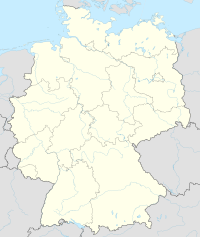| Babel: | ||
|---|---|---|
| ||
| ||
| ||
| ||
| ||
| ||
| Benutzer nach Sprache |
Vorlage: Dreispaltige Tabelle
{| width="830px"
|----- valign="top"
|
*...
*...
|
*...
*...
|
*...
*...
|}
|
|
|
to do
Artikel Lindau (Eichsfeld) schreiben (mit Wappen)
Wappen
http://www.ngw.nl/int/dld/d/dudersta.htm
Duderstadt
Origin/Meaning: The arms were granted on January 29, 1976. Duderstadt received city rights in 1247 from Duke Otto van Braunschweig. The oldest seal is known from 1255 and shows the two leopards of Braunschweig. All later great seals of the city have shown the two leopards. The small seals on the other hand showed shields with only a single leopard. Coloured images of the arms, always with 2 leopards, are known since 1592. The arms were slightly changed after the mergers in the 1970s; the blue colour of the nails and tongue was added, which was more historically correct.
The previous arms of Duderstadt
Literature : Stadler, K. : Deutsche Wappen - Bundesrepublik Deutschland. Angelsachsen Verlag, 1964-1971, 8 volumes.
Breitenberg
Origin/Meaning: The arms were granted on December 9, 1950. The arms show the local windmill, the typical landmark of the village until 1891, when it was destroyed by a storm.
Esplingerode
Origin/Meaning: The arms were granted on December 5, 1950. The hooks in the arms are taken from the seal of Lord Hennig von Esplingerode from 1369. The colours are taken from the nickname of the villagers, Wespe (wasps).
Brochthausen
Origin/Meaning: The arms were granted on June 9, 1938. The wolfs-hook in the arms is taken from the seal of Lord Luder Wrochthausen from 1457. The hook was already used for centuries as a village sign.
Desingerode
Origin/Meaning: The arms were granted on December 9, 1950. The rose in the arms is taken from the seal of Lord Johann von Desingerode from 1308.
Fuhrbach
Origin/Meaning: The arms were granted on December 5, 1950. The pine tree symbolises the forests in the region. The wavy bar is a canting element for the Fuhre brook (Fuhr-bach).
Gerblingerode
Origin/Meaning: The arms were granted on June 2, 1951. The arms show in the chief two crossed crosiers, symbolising the Teistungenburg monastery. The monastery had several possessions in the village and ordained the village priest. At the same time the village belonged to the city of Duderstadt, which is symbolised by the two lions of Duderstadt in the lower half.
Hilkerode
Origin/Meaning: The arms were granted on December 5, 1950. The arms show a kind of backback-holder, formerly used for carrying large packs on the back of people. These were formerly produced in the village.
Immingerode
Origin/Meaning: The arms were granted on December 27, 1950. The arms are based on the seal of Lord Brunonis de Immigerode, dating from 1266
Langenhagen
Origin/Meaning: The arms were granted on December 5, 1950. The arms show a tower, built in the village as a refuge for the formerly common floods in the region. The floods are symbolised in the base. The base also symbolises the small lake that is now present behind the protecting dam near the village. The pine trees symbolise the forests in the region.
Mingerode
Origin/Meaning: The arms were granted on December 5, 1950. The arms are based on the medieval seals of the Von Minnigerode family, dating from the 13th-15th century. As the present family still uses the hook in their arms, the hook was placed on a golden roundel. The roundel also symbolises a pancake, as the villagers are locally known as Pannkauken.
Nesselröden
Origin/Meaning: The arms show the cross used by the State of Mainz. The village historically belonged to Mainz and the cross was used on borderstones as a village symbol
Tiftlingerode
Origin/Meaning: The arms were granted on April 11, 1951. The arms show St. Nicholas, the local patron saint.
Werxhausen
Origin/Meaning: The arms were granted on November 3, 1951. The arms show a rooster, based on the local nickname of the villagers, Kückelhähne (Hahn=rooster).
Westerode
Origin/Meaning: The arms were granted on December 5, 1950. The arms show an owl, based on the local nickname for the villagers, 'die Ulen', the owls.
test
Text text text text text text text text text text text text text text text text text text text [1] Text text text text text text text text text text text text text text text text text text text [2]
Text text text text text text text text text text text text text text text text text text text [1]
- ↑ Zitattext3



